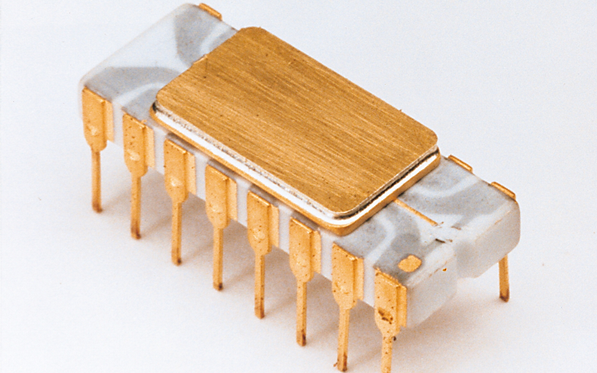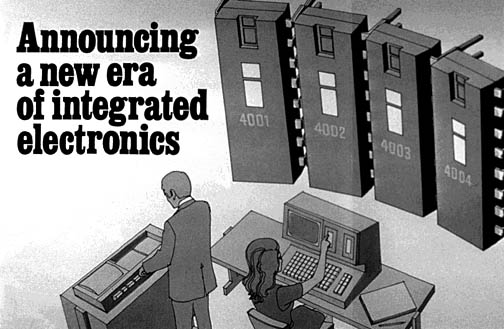Fortieth anniversary of the central processor

That’s all said - welcome to kat, where the most interesting details of the creation of the first microprocessor are revealed, and congratulations are also received from the Russian office of Intel.

November 15, 1971 could have remained just one more day in history if Intel had not released the world's first commercially available microprocessor - i4004. From that day on, a revolution in the technological industry began in the world, which led to the fact that today processors surround us wherever we go: they are in cars, in ATMs, in players and phones, computers and cameras, at home, at work, on holiday. We can no longer imagine our life without these little helpers who help us cope with the simplest and most complex tasks in life.
We congratulate all geeks, computer and IT professionals on this holiday - if not for you, today we would hardly be where we are!
As you know, Intel 4004 was the first microprocessor to contain the basic elements of a programmable computer in one chip. The credit for creating this small but central element of the chain belongs to: Federico Faggin; Ted Hoff Les Vadasz and Masatoshi Shima (Masatoshi Shima from Busicom).
On October 15, 2011, US President Barack Obama presented Federico Fajin, Ted Hoff and Stanley Mazor (Intel) one of the highest awards in the country - the US national medal for innovation, for their work on the Intel 4004 processor more than 40 years ago.
The history of the creation of the i4004 processor is amazing in some places - all the participants in its development had to literally invent something at every step. It all started because of the simple “it's illogical” when Busicom placed an order for the production of 12 chips for its calculator. It was the desire to reduce the number of microcircuits by creating a single microprocessor, and to miniaturize the whole architecture that led to the birth of the i4004 chip.
Ted Hoff and Stanley Meyzor proposed a new chip architecture, and Italian physicist Federico Fagin, who worked at Intel as the chief system designer for MSC-4, performed the work on translating the drafts into life, that is, the chip. It was he who developed (while working at Fairchild) the MOS silicon gate technology, which made it possible to create a new, before 1970, method of designing logic circuits.
The processor, which was created as a result of the joint work of brilliant engineers, could execute 60,000 (on average up to a maximum of 93,000) instructions per second, despite the fact that it took 15 years, it never became popular with the general public. Fame came only to his architectural "great-grandson" - i8080, but Intel's merit in unifying and creating just a small microchip was appreciated and led to the right development strategy, which we observe today.
In order to understand what a tremendous path has been traveled over these forty years, it’s enough to give just a few facts about the i4004: the processor was created for the Busicom calculator with an integrated printer and had 2300 transistors (for comparison, the second-generation Intel Core Duo has almost a billion transistors, 400,000 times more). The 4004 processor worked with a synchronization frequency of 740 kHz, which is more than 5,000 times less than modern central processors manufactured by the company. The manufacturing process by which the i4004 was manufactured was 10 micrometer (μm), and the most modern Intel processors are created using the 32-nm manufacturing process, which is linearly smaller by approximately 300 times, which led to an increase in area by 100,000 times.
In order to imagine the scale of change, it is enough to give one simple example: the size of a modern processor is 216 square millimeters. If it had been manufactured using technology forty years ago, its size would have been a rectangle of 7 x 3 meters. It would hardly fit into an apartment, not to mention a laptop.

Electronic News magazine cover of November 1971, which talked about the creation of the first commercially available microprocessor as a separate chip and the advent of a new era in computer technology.
I’m not lying if I say that no industry in the world is developing at the same pace as the creation of microprocessors. In many respects, this is a merit of Intel and those people who were busy creating the first microprocessor, the anniversary of which we celebrate today.
In the 71st year when the i4004 was created, Intel was only three years old. Robert Noyce and Gordon Moore, pioneers of the microprocessor industry of the time, could hardly have imagined the scale of the changes that would come about thanks to the efforts of their company in the future. Then the production of one transistor on a chip cost about $ 0.02 - today this figure shines with an additional five zeros and amounts to $ 0.0000002, which allows the company to produce powerful processors at an affordable price.
Thanks to Moore’s law, which we know as a simplified postulate: “the number of transistors on a chip doubles approximately every two years,” Intel literally pushes the technological composition forward, remaining at the forefront of progress thanks to new technologies, as well as reducing the technological process when creating processors.
According to numerous studies, Intel's market share in microprocessors is approximately 80% - you can calculate how many of the million PCs shipped every day ( 2010 data ) are equipped with a central processor manufactured by Intel. And these numbers will only grow in the future, with the advent of new device form factors (such as ultrabooks ) and the introduction of portable devices (primarilytablet computers ). According to Forrester's forecast, by 2015 there will be about 2.5 billion personal computers in the world, and this figure is primarily growing due to the emerging markets of Brazil, China and Russia.
Today, the i4004 is a matter of tender love for collectors who are looking for the first chips (as in the photo at the beginning): white-gold chips with gray traces on the white part (original case). These microprocessors, with no release date, were the very first in everything. They will remain forever timeless, proving that human sagacity and the desire for progress are truly inexhaustible.
PS In the IT-Galaxy community, they talk about the chronology of the development of processors, from i4004 to Core 2 Duo of the second generation: 1 part , 2 part .
